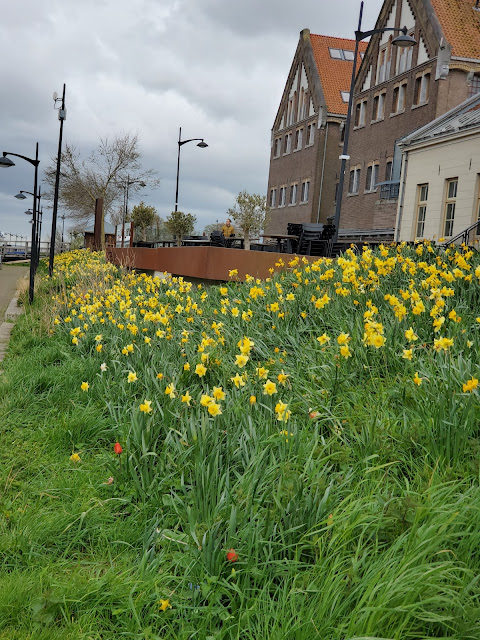 |
| I got this beautiful variety from my neighbor, who was even more of a Hippeastrum maniac than I am, but without a name. |
We do have spring bulbs here, commonly called Amaryllis. We don't have the massive displays, or the number of varieties to be found in tulips, but some of us have our own private manias, filling up every available spot in our gardens with what I consider to be equally elegant and equally anticipated spring displays. I alluded to them twice already, in Theme and Variation - the Amaryllidaceae and in My Pandemic Garden 1. Winter and Spring
 |
| One of the true Amaryllis species from South Africa, A. belladona. By Discott - Own work, CC BY-SA 3.0, |
First of all, they're not really in the genus Amaryllis, which consists of two species native to southern Africa. What we call by that name, through historical confusion, are in Hippeastrum, a genus of some 90 species native to tropical America. So much for the botanical geekery.
Though roughly the same shape as tulips, Hippeastrums are bent to the side, an adaptation for pollination by hummingbirds, and they have inferior ovaries, which means the seed capsules develop below the tepals, rather than above them as in tulips.
Over 600 hybrids and cultivars have been developed, drawing upon several of the wild species, much of it in Holland, the international center of bulb mania. Colors range mostly from red to pink to white, while some have an orangish tint. Some yellow-ish varieties have been bred, but there are no true brilliant yellows, and if you see blue Hippeastrums for sale, I have a bridge in Brooklyn I can sell you for cheap! There are no true blue or purple pigments in the genus. Some may be dyed the way they dye those horrible blue Phalaenopsis you see in grocery stores sometimes.
 |
| One of the species Hippeastrums my neighbor had, probably H. reginae. |
The early varieties appear as early as March, depending on the weather, and the parade of later varieties can continue into early May. Each stalk typically produces 4-8 blooms, and flowers can last up to a week. So with my brief betrayal to see the tulips in April, I didn't miss much.
 |
| At the show in Keukenhof, only a few Hippeastrums from the greenhouse were on display. |
So one can create his or her own spring spectacle with these subtropical beauties.
 |
| The common large red cultivar, whose flowers can be up to six inches across. |
 |
| A pretty, pink variety, probably "Apple Blossum." |
 |
| Hippeastrum papilio, the Butterfly Amaryllis, is a species said to be epiphytic in nature. It is said to bloom better if crowded in a pot, and that the roots need good aeration. |
 |
| This is a seedling from one of the large red commercial varieties. The color is true, but the flowers are substantially smaller. |
 |
| I don't personally care for doubled flowers other than roses, but this one came from my neighbor and I didn't have the heart to turn it away/ |
 |
| This variety, "Minerva," with white stripes remains my favorite of all the Hippeastrums. |










